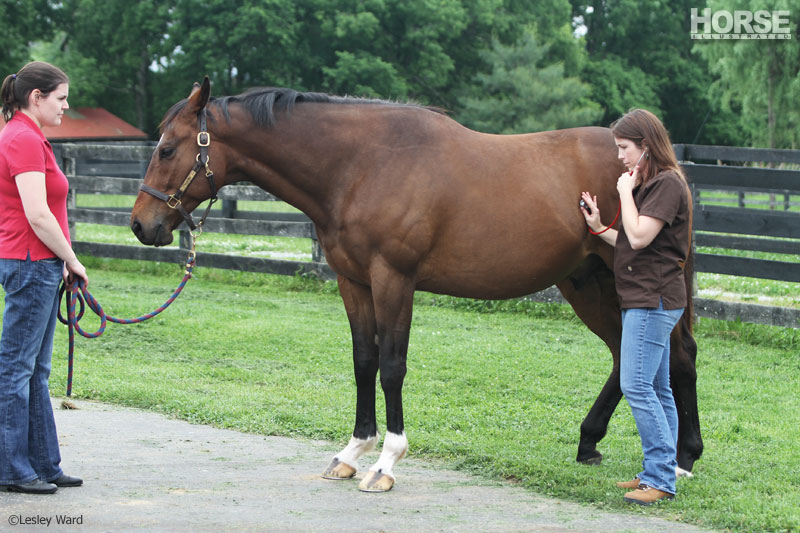The term colic, used to describe a horse experiencing acute abdominal pain, usually elicits worried responses from horse owners, and with good reason. Based on clinical signs alone, it’s often difficult to tell if a horse with colic is merely gassy or is suffering from something more serious, like a twisted intestine. Regardless of the cause, knowing how to identify common signs of colic and what to expect when the vet arrives will prepare you to help your horse.

“Classic signs of colic include pawing, biting at the sides and rolling,” explains Julie Dechant, DVM, associate professor of equine surgery at the University of California at Davis School of Veterinary Medicine. “However, more subtle signs may include reduced appetite, lying down, reduced manure production, looking at the sides and restless behavior.”
Although the severity of abdominal pain can certainly influence how dramatically a horse responds outwardly, his personality can also dictate the extent of clinical signs.
“Clinical signs in a horse can vary from simply not eating his morning grain to violently rolling on the ground,” says Whitney Knauer, VMD, large animal veterinarian at the College of Veterinary Medicine at Cornell University. “The temperament of the horse is important to consider; a Thoroughbred might respond much differently to a painful colic than a more stoic breed such as a draft horse.”
Take Action
If you see that your horse is showing signs of colic, it’s time to act.
“When a horse is colicking, it’s important to move him somewhere he can be monitored and that is safe, such as a small paddock by himself,” says Dechant. Continue to watch your horse’s behavior and note manure production.
Remove any food, including hay and access to pasture. If you are able to, assess his vital signs. “Temperature, heart rate, respiratory rate and intestinal sounds will be very helpful to your veterinarian,” adds Dechant. “Medication should not be administered without instruction by your veterinarian. But if medication has been administered, it is essential to relay that information to the vet.”
Although an old adage is to walk a colicking horse, this is not always necessary. “If the horse is lying quietly, there is no urgent need to walk him,” explains Dechant. “If he’s actively rolling, walking may distract him and prevent him from getting cast [stuck against the stall wall] or injured while rolling.”
Calling the veterinarian is the next crucial step in managing a colic case on your farm. “I like to ask owners to describe exactly what the horse is doing so I can get a picture of severity in my head as I drive out to the farm,” says Knauer. “Also, I’d like to know the duration of signs.”
Making a Diagnosis
Once your veterinarian arrives, she will conduct a colic exam, with emphasis on the horse’s gastrointestinal (GI) tract.
“The first thing I do during a colic exam is simply look at the horse and what he is doing,” says Knauer. “From there, the most important parameters are heart rate, mucous membrane color, capillary refill time and gut sounds.” Horses experiencing colic usually have an elevated heart rate, which directly correlates with pain: the higher the heart rate, the more severe the pain usually is.
After general demeanor and vital signs are assessed, your veterinarian may perform additional diagnostics, including a rectal exam and placing a nasogastric tube, depending on the severity of the colic and its duration. The horse is usually sedated beforehand for these more invasive procedures.
The most common sedative initially used for a colic case is called xylazine. Given intravenously, it’s short-acting, lasting roughly 20 minutes. Although helpful for restraint and allowing for safe examination of a painful and possibly anxious horse, xylazine also has analgesic (pain control) and muscle relaxation properties.
The horse’s response to this drug will help the veterinarian further assess the extent of pain he is experiencing. “It’s important to use something short-acting so we can measure how long it takes for the horse to become painful again,” explains Knauer.
Once your horse is sedated, your veterinarian can find out what is going on in the gastrointestinal tract by placing a nasogastric tube.
“Horses are unable to vomit, which would relieve the pressure of any fluid building up in the stomach,” says Knauer. “As such, horses are at risk for stomach rupture if the stomach is excessively full. A nasogastric tube is used to determine if there is too much fluid or gas in the stomach, and can relieve that pressure if needed.”
A nasogastric tube is placed through the horse’s nostril and down the esophagus to the stomach. Placement of a nasogastric tube will tell your vet many things. If a substantial amount of foul-smelling fluid is obtained from the tube after it reaches the stomach, this indicates some sort of obstruction in the small intestine that is causing fluid to get backed up in the stomach.
If no fluid is obtained, this will also tell the vet valuable information. “This tells us either what we aren’t dealing with, or that we are still in the early phases of the process and with proper pain and feeding management, we can prevent progression of colic to something more serious requiring surgery or more involved therapeutics,” says Dechant.
Additionally, if no fluid is obtained from the stomach through the nasogastric tube, the veterinarian can use this opportunity to administer therapeutics such as water and electrolytes if the horse is dehydrated, or mineral oil or Epsom salts if the vet suspects an impaction.
While placing a nasogastric tube will tell your veterinarian about the front third of the horse’s digestive tract, the rectal examination will give some insight into the last third. Your veterinarian is feeling for parts of the GI tract that are out of place and distended with feed or gas, explains Knauer. The consistency and presence of manure is also noted.
“The presence of normal, formed manure can suggest a milder colic or may indicate that the colic is relatively recent in onset,” says Dechant. “Absence of manure and/or the presence of mucus suggests a more protracted duration and more significant insult to the intestinal tract.”
Occasionally, impactions can be felt directly on a rectal exam. Other times, only gas-filled loops of intestine or the misplacement of a part of the colon can be identified. Since the large size of a horse’s abdomen prohibits a veterinarian from palpating the entire GI tract, sometimes nothing unusual will be felt.
“Absence of abnormalities during the rectal examination does not necessarily mean that the horse is normal,” says Dechant.
Treatment Plan
After a colic examination, your veterinarian will have enough initial information to begin a treatment plan. “My goal is to either fix the colic with appropriate fluid and pain management, refer the horse to a teaching hospital for surgery or intensive medical monitoring, or determine if the colic is too severe to resolve and end the suffering of the horse through euthanasia,” says Knauer.
The basics for on-the-farm colic management begin with fluid replacement. Horses with colic are usually dehydrated, and if an impaction is suspected, fluid administration will help break it up. Fluids are usually administered through the nasogastric tube, or intravenously for more severe cases.
Your horse is also given pain medication. The most common medication used to aid in abdominal pain is the non-steroidal anti-inflammatory drug flunixin meglumine, also known as Banamine.
After administering treatment, your veterinarian will talk with you about monitoring your horse. This is extremely important and can be an extensive effort, as a colic case (typically an impaction colic) can take days to resolve.
“The owner should assess the horse for further signs of discomfort,” Dechant explains. “If he has received an analgesic such as Banamine, recurrence of colic signs before 12 hours should prompt a recheck with the veterinarian.”
Manure production should also be monitored. “Normally, a horse should pass several piles of manure during the day,” says Dechant. “Absent or scant manure production over 12 hours should prompt a re-examination.” If your horse was initially given mineral oil, you should see an oily sheen under the tail (or in the manure) roughly 12 hours later.
One of the most important aspects of managing a colic case on the farm is to withhold your horse’s feed until clinical signs resolve.
“If the horse has remained comfortable, passed several piles of manure, and has a good attitude and appetite over 12 hours, then he can usually be fed small amounts of hay divided into three or four small feedings,” Dechant says.
As your horse continues to improve, these feedings can slowly increase over the next few days. You should remain vigilant in observing your horse’s appetite, overall demeanor and manure production for up to a week after he is initially examined and treated for colic.
There’s no doubt that a colic episode can be a scary thing, even for experienced horse owners. However, knowing what to expect in terms of clinical signs and understanding what is going on during a colic exam can help alleviate some of the uncertainty that accompanies a case of colic.
Further Reading
Making the Colic Call
7 Tips for Preventing Colic
Colic Topiclist
This article originally appeared in the October 2013 issue of Horse Illustrated. Click here to subscribe.







Great advice. It’s quite scary dealing with colic.